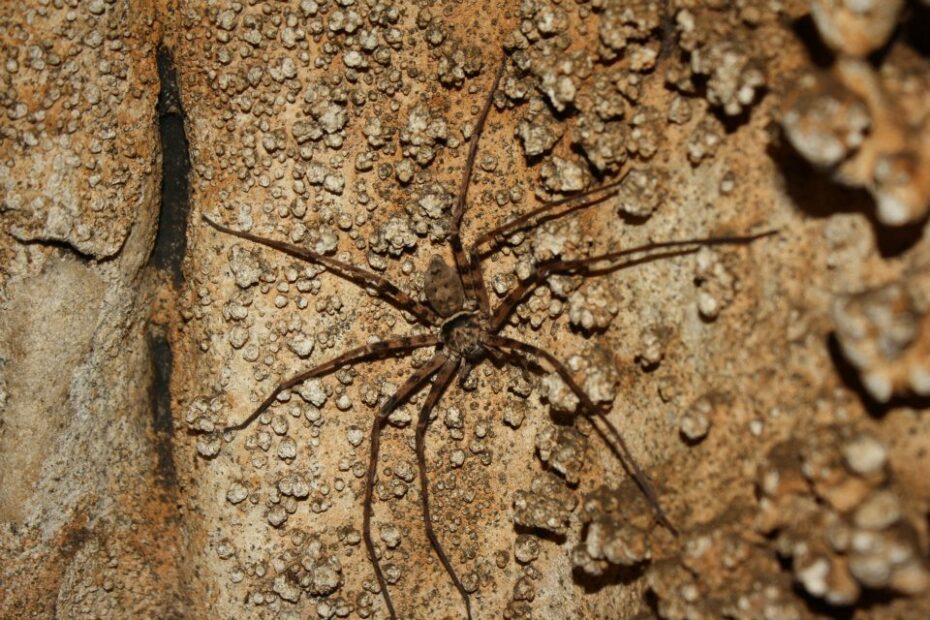The dark and mysterious world of caves often conceals creatures that inspire awe and curiosity. Among these enigmatic inhabitants is the Thailand Cave Huntsman Spider, a species known for its cryptic existence within the subterranean realm. While these spiders may appear intimidating due to their size and appearance, it’s essential to demystify their nature and assess whether they pose a threat to humans.
The Thailand Cave Huntsman Spider: A Closer Look
Before delving into the question of their danger, let’s explore the characteristics and behavior of the Thailand Cave Huntsman Spider.
Size and Appearance
These arachnids are relatively large, with leg spans that can reach up to 6 inches (15 centimeters). Their bodies typically exhibit shades of brown and beige, allowing them to blend seamlessly into their cave surroundings.
Nocturnal and Elusive
Thailand Cave Huntsman Spiders are primarily nocturnal, which means they are most active during the night. Their reclusive nature and preference for dark, humid cave environments make them elusive and challenging to observe.
Exceptional Predators
These spiders are skilled hunters, relying on their speed and agility to chase down insects and other small creatures within the cave. Their venom, while not harmful to humans, is potent enough to immobilize their prey.
Are They Dangerous to Humans?
Now, let’s address the pressing question: Are Thailand Cave Huntsman Spiders dangerous to humans?
Non-Venomous to Humans
The good news is that the venom of these spiders is not considered harmful to humans. While they do possess venom, it is primarily used to subdue their prey, which consists of insects and other small arthropods found within the caves.
Minimal Interaction
Due to their nocturnal and reclusive behavior, interactions between humans and Thailand Cave Huntsman Spiders are infrequent. In most cases, these spiders prefer to avoid contact with humans and will retreat or remain motionless if encountered.
Defensive Behavior
Like many spiders, Thailand Cave Huntsman Spiders may exhibit defensive behavior if they feel threatened. This can include raising their front legs or attempting to flee from perceived danger. However, they are generally non-aggressive and do not pose a danger to humans.
Role in the Ecosystem
It’s important to recognize that these spiders play a valuable role in the cave ecosystem. As effective predators of insects and arthropods, they contribute to the balance of the cave’s food web. Their presence helps control populations of unwanted pests within the cave environment.
Conservation Concerns
While Thailand Cave Huntsman Spiders are not dangerous to humans, they face conservation challenges that warrant attention.
Habitat Destruction
One of the primary threats to these spiders is habitat destruction. Human activities such as mining, tourism, and development can lead to the destruction of limestone caves, jeopardizing the delicate ecosystems where these spiders reside.
Limited Knowledge
The elusive nature of these spiders has resulted in limited knowledge about their biology and behavior. This knowledge gap hinders conservation efforts and underscores the importance of further research.
The Thailand Cave Huntsman Spider, despite its imposing appearance, is not dangerous to humans. Its non-venomous nature and preference for avoiding human contact make it an intriguing but harmless inhabitant of Thailand’s cave systems.
As we continue to explore and understand these remarkable arachnids, we gain a deeper appreciation for the intricacies of the natural world. Rather than fearing them, we can marvel at their adaptations and their role in maintaining the delicate balance of cave ecosystems. Ultimately, the Thailand Cave Huntsman Spider serves as a testament to the diversity and wonder of life within our planet’s hidden realms.
FAQs About Thailand Cave Huntsman Spiders
1. Q: What are Thailand Cave Huntsman Spiders, and where are they found?
- A: Thailand Cave Huntsman Spiders, scientifically known as Heteropoda thailandica, are arachnids that inhabit the limestone caves of Thailand. They are adapted to the dark and humid cave environments.
2. Q: Are Thailand Cave Huntsman Spiders dangerous to humans?
- A: No, these spiders are not dangerous to humans. While they possess venom, it is not harmful to humans. They primarily use their venom to immobilize prey, which consists of insects and other small arthropods.
3. Q: Why are encounters with Thailand Cave Huntsman Spiders rare?
- A: Encounters with these spiders are infrequent due to their nocturnal and reclusive behavior. They prefer to remain hidden and avoid contact with humans.
4. Q: What are the distinctive characteristics of Thailand Cave Huntsman Spiders?
- A: These spiders are relatively large with leg spans of up to 6 inches (15 centimeters). They have brown and beige coloration, allowing them to blend into the cave environment effectively. They are skilled hunters and possess specialized sensory organs.
5. Q: Do Thailand Cave Huntsman Spiders exhibit defensive behavior?
- A: Yes, when threatened, these spiders may exhibit defensive behavior, such as raising their front legs or attempting to flee. However, they are generally non-aggressive toward humans.
6. Q: What role do Thailand Cave Huntsman Spiders play in cave ecosystems?
- A: These spiders serve as effective predators, helping control insect and arthropod populations within the caves. They contribute to the balance of the cave’s food web.
7. Q: What conservation challenges do Thailand Cave Huntsman Spiders face?
- A: Habitat destruction is a significant threat to these spiders, as limestone caves are often destroyed due to human activities like mining and tourism. Additionally, limited knowledge about their biology hinders conservation efforts.
8. Q: Why is it important to study and protect Thailand Cave Huntsman Spiders?
- A: Studying and protecting these spiders is crucial for preserving the delicate cave ecosystems they inhabit. They contribute to biodiversity and offer insights into the intricate interactions within caves.
Featured image courtesy: https://www.reddit.com/r/Entomology/comments/ypysx/cave_spider_thailand/
